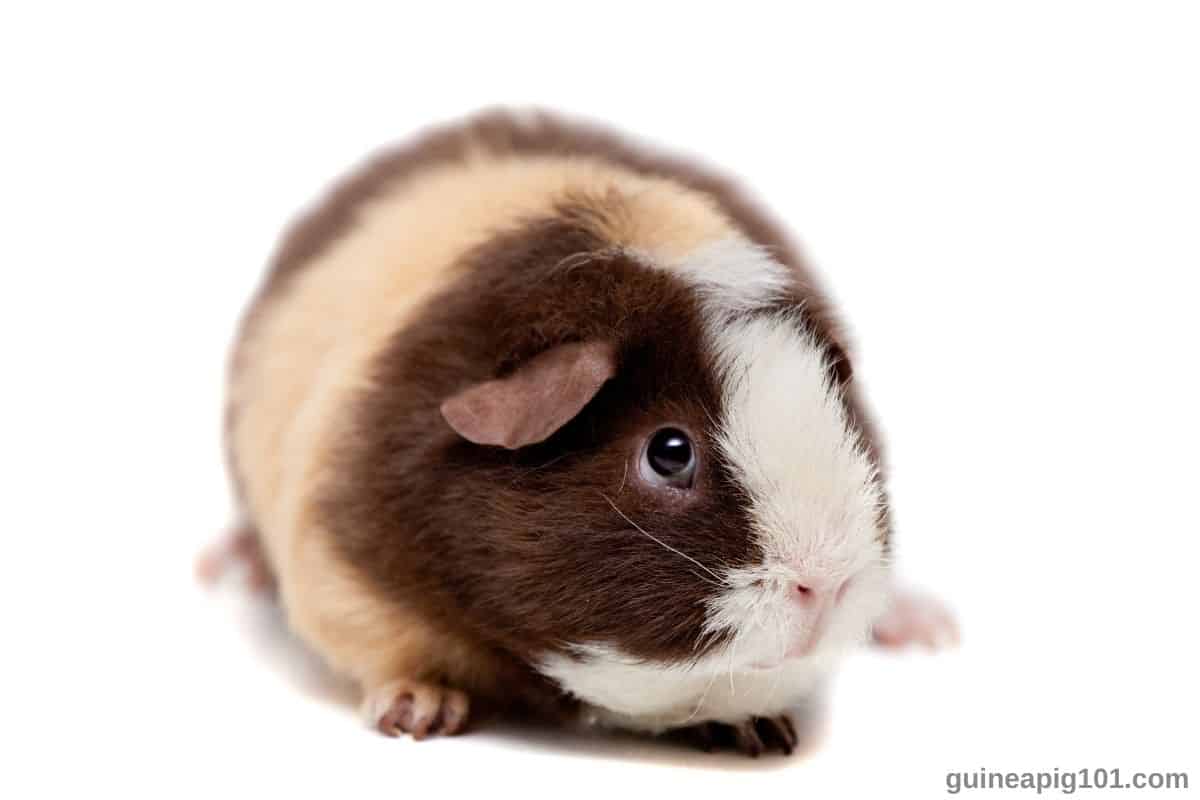The Teddy guinea pig is one of the most popular guinea pig breeds out there, and for a good reason. These short-haired guinea pigs breed energetic and friendly yet very easy to take care of.
As their name suggests, Teddy guinea pigs are soft and fluffy, just like a Teddy. They are known for their sweet, friendly, and cuddly nature, which makes them one of the best breeds for children.
They are available in two different variants. One with a soft coat while the other has a rough coat. The rough coat is more readily available than the soft coat ones; however, they make an excellent pet.
If you are looking forward to learning more about Teddy guinea pigs, right from the Origin, Appearance, Diet, Care, and much more, then read this article till the end, and I shall ensure you know everything about them in detail.
Teddy Guinea Pig Origin
The Teddy guinea pigs were first discovered in the early 1970s. Their unique coat and personality soon made them a popular breed, which was later recognized by American Cavy Breeders Association in 1978.
Teddy guinea pigs were discovered as a result of genetic mutation. Since guinea pigs are often used for experiments, the breed was likely the result of the same.
In the teddy guinea pig’s case, the genetic variation is likely to have occurred by cross-breeding American and Abyssinian guinea pig.
As a result, we have a guinea pig with thicker and coarse fur like an Abyssinian guinea pig. Still, the other body structure and appearance are similar to an American guinea pig.
The genetic mutation between the two breeds seems to affect only their physical appearance while the guinea pigs’ health and mental condition remain sound.
Although many experts argue that the genetic mutation does severely affect guinea pigs’ health and lifespan, there is no concrete proof to back the claim.
Physical Appearance Of Teddy Guinea Pig
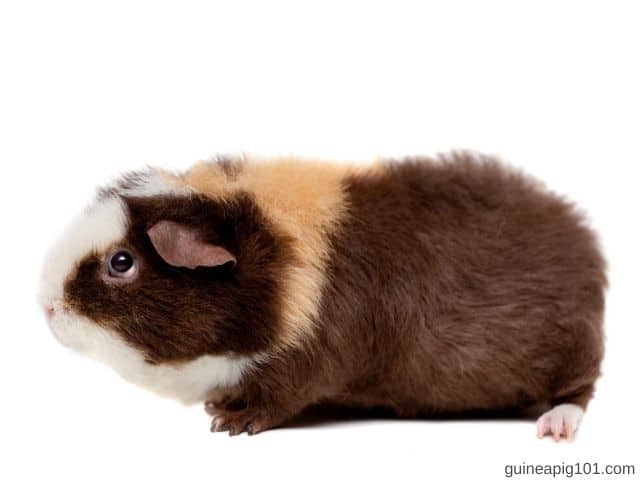
Teddy guinea pigs have a distinct appearance that can be easily recognized. They have a rough dense, and short coat covering their entire body.
The coat is quite short and doesn’t even have any rosette as other common guinea pig breeds have.
They also have a roman nose( A nose turned upward and slightly curved) just like American guinea pigs.
Although their nose is wider as compared to other guinea pig breeds. Many people often get confused between an American and Teddy guinea pigs due to their similar body structure. However, they can be easily distinguished by their coat.
Teddy Guinea Pig Size
How big does a Teddy Guinea pig get? A teddy guinea can grow up to 12 inches(30 cm) in length. However, the growth might depend upon the care and diet provided to them. Let us have a look at their growth rate:
| Age | At Birth | 8 weeks | 16 weeks | Maturity |
|---|---|---|---|---|
| Growth Rate | 3-4 inches (8-10cm) | 6-7 inches (15-18cm) | 8-10 inches (20-25cm) | 10-12 inches (26-30cm) |
As you can check it out, Teddy guinea pigs are usually 3-4 inches(8-10cm) at the time of birth. The Average Litter size is 3-4. The size of the guinea pigs at the time of delivery might vary depending upon the litter size.
Guinea pigs usually grow at a lightning-fast pace during the first few weeks. They can grow up to 6-7 inches(15-18cm) just in the first eight weeks of birth.
After the initial week, the growth rate slackens down, and they grow another few inches reaching up to 8-10 inches(20-25cm) at the end of 16 weeks.
Moving ahead, they continue to grow at a languid pace reaching the mark of 10-12 inches(26-30cm) till they reach the maturity point.
However, the size might vary depending upon the gender you own. In most cases, The male guinea pigs tend to grow larger as compared to female guinea pigs.
Teddy Guinea Pig Weight
How much does a Teddy guinea pig weigh? A teddy guinea pig can weigh anywhere between 800-1400 grams, while the females are smaller than males and weigh anywhere between 800-1200 grams. A male guinea pig can weigh anywhere between 1000-1400 grams.
However, just like any other pet animal, the weight might differ depending upon a lot of factors.
| Guinea Pig Weight | New Born | 8 Weeks | Maturity |
|---|---|---|---|
| Male | 90-110 grams | 500-550 grams | 1000-1400 grams |
| Female | 70-90 grams | 420-450 grams | 850-1200 grams |
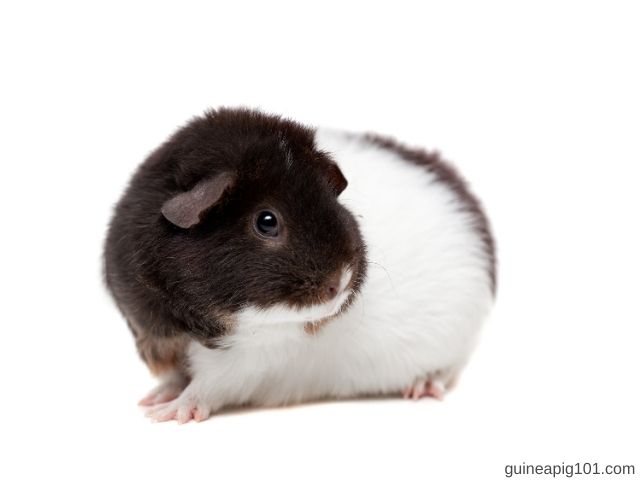
A newborn Teddy guinea pig can weigh anywhere between 70-110 grams depending upon its gender and litter size.
The guinea pig’s weigh increases quickly as they grow large during their first eight weeks. At this point, they can weigh anywhere between 420-550 grams.
The male seems to weigh more and move ahead, and you can quickly tell the difference in size and weigh between the two.
After the quick growth phase, the growth rate of guinea pigs slackens quite a bit. They will continue to add on to their weigh until they reach the maturity mark, where they might weigh anywhere in between 850-1400 grams.
The male will remain on the heavier side, but this might not be the case always.
It is crucial to keep track of your guinea pigs weight on a regular interval and make sure they are healthy.
Underweight or Overweight can be a sign of some health issues in guinea pigs. You can use a weight scale to weigh your guinea pigs regularly.
Alternatively, Guinea pig Size-O-Meter from the PMFA can also help you understand whether your guinea pig is underweight, overweight, or a perfect fit.
Teddy Guinea Pig Color
The color of Teddy guinea pigs might vary widely. Right from solid colors, pattern, Roans to Tri-color, they are available in a wide range of colors and patterns to choose from.
Teddy guinea pigs are available in various colors right from White, Black, Brown, Grey, Chestnut, Golden, and many more. You might also find some with a mix of White-brown, Black and White, etc.
They are also available in various patterns, so you will definitely find one for your liking.
Teddy Guinea Pig Lifespan
What is the average lifespan of a Teddy Guinea pig? The average lifespan of a Teddy guinea pig is anywhere between 4-5 years. However, they have been reported to live up to 8 years under ideal circumstances.
If you want to learn more about the lifespan of guinea pigs and how you can improve the same, I recommend you to read our article: Guinea pig Lifespan and Ways to improve it.
Teddy Guinea Pig Temperament
Teddy guinea pigs are the Active, Social, Curious, and most Fun loving guinea pig breed out there. They are social with other cage mates as well as human companions.
Teddy guinea pigs like to be gently handled and petted. They also enjoy some cuddling, which makes them popular among children.
Teddy guinea pigs are also pretty smart and active. If you are enthusiastic and train your guinea pigs well, then they might learn a few tricks and commands.
They are also extroverted and energetic, which makes them a popular choice. However, just like human beings, every guinea pigs have a distinct personality.
While the nature of one might totally be different from the other, teddy guinea pigs do share these traits.
Are Teddy guinea pigs friendly?
Teddy guinea pigs are definitely one of the most social and friendly breeds of guinea pigs available out there. This breed’s calm and extrovert nature makes them one of the best choices, even for children.
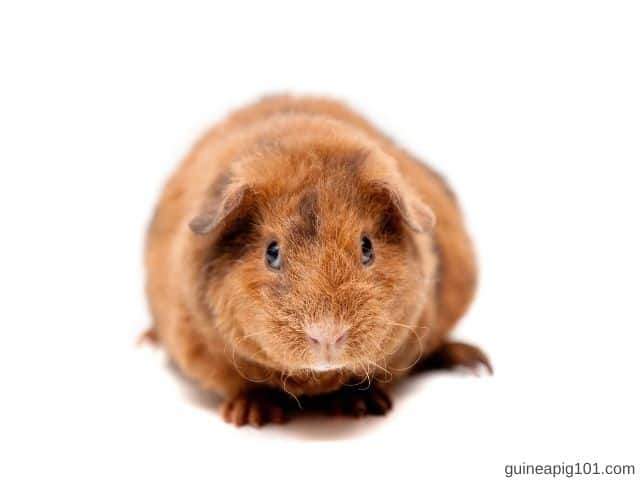
Although their character may differ from one guinea pig to another in general, the teddy guinea pig carries a calm and friendly temperament.
Care Of Teddy Guinea Pig
Teddy guinea pigs are one such breed that is really easy to take care of. If you could take care of some basic stuff like Diet, Habitat, and other basic needs, then you are good to go.
The grooming requirement of a Teddy guinea pig is also fundamental.
As they have dense short hair, just regular brushing can help them keep them in good shape once in a while. Let us check out some of the essential care requirement of teddy guinea pigs:
Diet Of Teddy Guinea Pig: What do teddy guinea pigs eat?
The Teddy guinea pigs also have simple dietary needs, just like other guinea pig breeds. Hay is the staple part of their diet, contributing 80% of their nutritional requirement.
While fresh veggies and pellets provide 15% and 5%, respectively, apart from these, you should also feed some occasional treats and fruits to spice things up in their diet.
Fresh Hay
Fresh hay is the staple part of the teddy guinea pigs diet. Their diet should mostly contain fresh Timothy hay only. Hay provides guinea pigs with essential calories and fiber, which is required by their body daily.
It is recommended to serve timothy hay only as it balances nutrients, fat, and protein needed by the guinea pigs.
Good quality hay are must for our guinea pigs. I personally love farm fresh hay from small pet select. They are really nutritious.
Although there are other types of grass available in the market like Alfalfa hay, Oats hay, etc. this hay contains an excess amount of calcium and fat, which is terrible for your guinea pig’s health.
Also, make sure that your guinea pig has enough hay at all times. Lack of hay in their diet can upset their digestive system and make them ill, which can also adversely affect their lifespan.
So, provide fresh hay to your guinea pigs daily. If you want to learn more about hay types and how to store and feed them, you must read our article: A complete guide on hay for guinea pigs.
As you have already understood the importance of hay in a guinea pig’s diet, you must also ensure that the hay provided to them are of good quality.
Some cheap brands tend to mix a variety of hay to cut down on prices, that are not beneficial for our guinea pigs.
So, always ensure you provide them with good quality hay only.
Fresh Vegetable and Herbs
Fresh vegetables and herbs account for 15% of the total nutritional requirement of guinea pigs every day.
It is also imperative to provide fresh vegetables daily because it provides guinea pigs with Vital vitamins and minerals, which hay alone cannot do.
Experts recommend serving at least a mix of 5-6 different types of vegetables daily. Provide a cup of fresh veggies and herbs daily.
Also, make sure that the vegetables and herbs you choose are low in calcium and high in Vitamin C so that they can have a well-balanced diet.
Vitamin C is an essential part of a guinea pig’s diet. Guinea pigs cannot synthesize their own Vitamin C; thus, they need a diet supplement.
Veggies like Kale, Parsley, Cabbage, Spinach, Chicory, Dandelion green, Turnip Green, Romaine Lettuce, Green bell pepper, Brussels Sprouts, etc. are rich in Vitamin C thus we need to feed more of these veggies regularly.
You can mix Lettuce, Tomatoes, Zucchini, Cucumber, Etc. With these vegetables and serve the same to your guinea pigs.
If you don’t know about the Vitamin C requirement for guinea pigs and how you can fulfill the same then I would recommend you to go ahead and read our guide: Vitamin C For Guinea pigs
Please Note: If you are introducing a new vegetable or herb in your guinea pig diet, do it slowly. The guinea pig has a sensitive digestive system, which can get upset if we change their diet frequently.
Also Read:
- What do you do if your guinea pig won’t eat vegetables? (Reasons & Tips)
- Growing Food For Guinea Pigs: Easy to grow Vegetables, Herbs & More
Pellets
Pellets are an excellent addition to our guinea pigs diet, especially when your guinea pig is picky on its veggies. It provides all-round nutrients right from fiber, Vitamin C to all other minerals needed by our guinea pigs.

Although pellets are No Substitute for fresh vegetables, it does provide guinea pigs with essential nutrients necessary for their body.
Some guinea pigs are really picky on their veggies, and it is quite possible that your guinea pigs don’t eat enough vegetables.
In such a scenario having good quality pellets supplementing their diet is a lifesaver.
We should serve the 1/8-1/6 cup of pellets to our guinea pigs daily. The serving size depends upon diet, age, and similar other factors of your guinea pigs.
Treats
Commercial treats and fruits as a treat are also a great way to spice up your guinea pig’s diet.
Not only fruits and other treats add up to their diet flavor; it also provides some great nutrition to them.
You should serve any treat in a small quantity once or twice a week.
You can also add occasional treat in your guinea pig’s diet. They are handy, especially if you are training your guinea pigs. There are lots of commercial treats available for your guinea pig you can choose any good one from them such as Oxbow apple treat and Oxbow strawberry treat.
Please note: Excessive amounts of treat can lead to the consumption of too much fat and sugar, which can adversely affect our guinea pig’s health in the long run, So, it is recommended to serve only a small quantity once in a while.
There are a wide variety of treats that we can offer to our guinea pigs. Right from fresh fruits like Oranges, Apple, Kiwi, Strawberry to other commercial treats, there are a lot of options to choose from.
Water
Providing fresh and clean water to our guinea pigs is an important aspect which you cannot neglect. Guinea pigs can consume anywhere between 50-300ml of water every day.
Although the consumption is dependent on weather, diet, temperature, and lots of other factors, it is still essential that you provide fresh and clean water at least twice a day.
Learn more about the water requirement of your guinea pig: Water for your guinea pig: What type, How much and more?
Some guinea pigs might not drink water if it warm due to summer heat, so changing the water frequently ensures your guinea pig is well hydrated.
Please make sure you only serve water at room temperature to your guinea pigs. Coldwater can lead to digestive issues in guinea pigs.
Although you can give water either in a bowl or a water bottle to your guinea pig, it is strongly recommended to use bottles only as it keeps the water clean and free from debris.
Teddy Guinea Pig Habitat
The habitat requirement of a teddy guinea pig is quite simple. Just like any other guinea pig breeds, they also need a large cage, good bedding followed by some toys and food and water dishes to store the same. Let us have a close look at all their needs.
Cage
The cage we choose for our teddy guinea pig must be of decent size. Experts recommend at least 7.5 sq feet area must be there for them to eat, play and exercise.
Guinea pigs are caged animals, which means they spent most of their time in their cage. Thus their cage must have an area dedicated to play, eat, and rest.
We must also make sure that the cage is located in a well-ventilated area away from the kitchen area so that the fumes from the kitchen don’t harm our guinea pigs.
The area must also have a stable temperature ranging from 65 to 75 degrees F (18 to 24 degrees C). Anything above or below can make your guinea pig uncomfortable or even ill.
Unfortunately, there are only a few ready-made cages available in the market, which checks all the requirements. We have tried our best and tested out a lot of cages to find you the best.
Bedding
Bedding is another crucial choice to make while housing a guinea pig. But why do we need bedding? Bedding is vital because of the following reason:
- It helps keep the floor dry and clean by absorbing the waste(pee) guinea pig creates
- It helps control the odor; thus, you need not clean the cage daily. Although spot cleaning is required daily, a thorough cleaning can be done once in a week or so.
- Most commercially available cages have a hard or wired bottom that is harmful to our guinea pigs’ feet. Thus having a layer underneath to cover the same helps quite a bit.
When it comes to choosing a bedding for your guinea pig, there are a lot of options available out there. But not all types of bedding are safe for our guinea pigs.
There is a lot of litter which can do more harm than good to our guinea pigs. Thus choosing the right bedding is really important.
Food bowls
Food bowls and hay racks are yet another addition to your guinea pig cage, which helps a lot by keeping the food in a place.
Having a good quality food bowl that doesn’t tip over can help reduce the mess your cute cavies will create.
As you might have already known by now, that guinea pigs are messy, especially when it comes to food.
So, serving food in a bowl and using hay racks for hay will create less mess in your cage; thus, less time in daily maintenance.
Water bottle
Water bottles are an essential part of a guinea pig cage setup. Guinea pigs need access to clean and fresh water at all times.
On average, a guinea pig can drink anywhere between 50-300ml of water daily. Thus having their water bottled filled at least twice a day is vital so that they remain hydrated.
We must also ensure that the water bottle we choose are leakproof so that it doesn’t leak and soak the entire bedding of your cage, creating havoc and making your guinea pig ill.
Toys and Hiding spaces
Guinea pigs are caged animals, and they do spend most of their time in their cage. Thus having some toys for physical and mental stimulation is really important.
Unless you can give them a few hours of floor time daily, it is recommended to have lots of toys in their enclosure. Toys are one of the best boredom killers for your guinea pigs.
It keeps your guinea pigs busy for several hours, which is essential. Guinea pigs love tunnels, hammocks, and other chew toys in their cages.
Apart from these, guinea pigs also need some Hideouts in their cage. Shelters are pretty essential for our guinea pigs as they love to burrow beneath them and take a quick nap.
Guinea pigs are prey animals, so when you first get a new guinea pig, they will need something in their cage to hide in. Having a place to hide reduces the stress of transition to a new environment as they feel more secure.
How To Groom Teddy Guinea Pig
Grooming teddy guinea pigs is quite easy and straightforward. A teddy guinea pig’s grooming requirement is minimal compared to other guinea pig breeds like Sheltie or Abyssinian guinea pig.
Brushing them once a week and clipping their nails every month will do the trick with this breed.
Although if your guinea pig has an active grease gland, then you might need to spend a few extra hours every month to keep it clean.
Let us check out some of the basic grooming need of a teddy guinea pig.
Also Read: Guinea Pig Grooming Each Other: Self Grooming, Barbering & More
Brushing A Teddy Guinea Pig
Brushing is one of the primary tasks to begin with while grooming your teddy guinea pigs. While Teddy guinea pigs don’t need daily brushing but doing so once a week helps remove any debris in their coat and maintain a dense coat.
Brushing also helps remove any excess hair stuck in their fur while your guinea pig sheds them away.
Brushing a teddy guinea pig is really straightforward. Just take a soft bristle brush and comb in the direction of their hair right from nose to their rump. You can repeat the process a few times from all sides to get it done.
Note: Please make sure you use a good quality soft bristle brush to avoid any injury to your guinea pigs.
Nail Clipping A Teddy Guinea Pig
Trimming your guinea pig’s nails is one part of guinea pig grooming that you cannot forego. Guinea pigs have a fast-growing nail that needs trimming every month.
If we do not trim their nails regularly, their nails will grow long and start to curl towards their toe, hurting it, causing difficulty in walking and a lot of pain.
If you are a total beginner, it can be a daunting task for you. in such scenarios, you can either ask a friend who has prior experience or visit a vet.
You can watch them do the job and learn the same quickly so that you can do it yourself next time.
You will need a good quality nail clipper to make your job easier. If you want to learn more about clipping your guinea pig nails, watch the video to learn more.
A quick tip: You can hold your guinea pig by wrapping them in a towel and put their paws above a flashlight. You will be able to see through the nails and veins in them. Just be careful and use a good pair of clippers to clip off the new growth, and you are good to go.
Cleaning their Grease glands
Grease glands are glands which secrete a greasy substance which guinea pig uses for scenting and marking purpose.
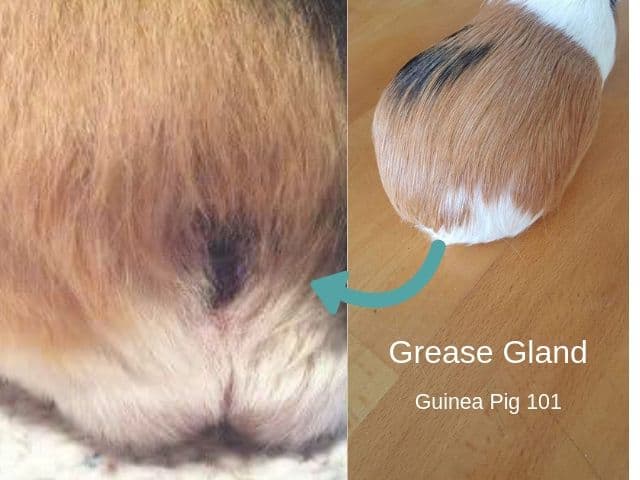
If you have a male guinea pig, they will have a more active grease gland than a female. If your guinea pig has an active grease gland, you will need to clean it every few weeks.
Not cleaning them on time can lead to several health issues in your guinea pigs. It will also create a strong smell, which can be daunting for some people.
You can learn more about grease gland and how to clean the same from our article below:
- Guinea pig grease gland and how to clean it?
- How To Clean A Guinea Pig’s Bottom? (A Step By Step Guide+Tips)
Bathing A Teddy Guinea Pig
When it comes to bathing a teddy guinea pig, it is not something that we will have to do regularly. In fact, guinea pigs don’t need a bath until and unless their coat is soiled and smelly or the vet recommends to do so.
Bathing a guinea pig removes the oil from their skin, which causes some harm to them. Thus regularly washing your guinea pig for no reason does nothing good to them.
Although if your guinea pig is dirty and smelly, giving them a quick bath with some good quality guinea pig shampoo can freshen up.
Bathing your guinea pig is quite straightforward; you just need to follow some simple steps:
Bath your guinea pig in a small tub with some lukewarm water. Just fill the tub till the water reaches their stomach, and then carefully put your guinea pig in it.
Lather up using some good quality guinea pig shampoo and rinse it off thoroughly.
You can then use a towel or a hairdryer to dry them up before letting them back into their cages.
Do Teddy Guinea Pigs Shed?
Teddy guinea pig does shed some hairs. In fact, they are light shedders. You will notice some heavy shedding during the spring and early summer to prepare their coat for the summer. In other months you will see very light shedding.

Although regular brushing during their shedding schedule can help control most of the mess.
We do have some tricks to keep your home and area hair-free. To learn more, you can read our article on the same: Do Guinea pigs shed? How to control their shedding?
Are Teddy guinea pigs hypoallergenic?
Teddy guinea pigs are not hypoallergenic. In fact, No animal with hair, fur, or feather can trigger an allergic reaction to human beings.
Although there are some ways to control and minimize the allergy to guinea pigs, we have shared in our previous articles, if you wish to learn more about the same, then we would recommend you to check it out: Are guinea pigs hypoallergenic? Tips for families with allergy!
How Much Do Teddy Guinea Pigs Cost?
A teddy guinea pig can cost you anywhere between 20-40$, although the price can vary depending upon where you get your guinea pig, How healthy they are, and how good the breed quality is.
- A teddy guinea pigs need a cage of atleast 7.5 sq feet area.
- Quality bedding is must to ensure your guinea pigs remain healthy and their cage remains clean.
- Providing a good quality diet is a must.
- Make sure you provide them with enough floor time to play and exercise
- Although the teddy guinea pigs doesn’t have much grooming needs they do need some care on a weekly basis.
- Teddy guinea pigs also have fast growing nails which needs regular clipping. Failing to do so can be bad for their health.
- Make sure you bath your teddy guinea pig only when it is required. Bathing them frequently can be bad for their health.
- Regular vet visit(once in 3 months) helps in preventing diseases so that your guinea pigs can live a long and healthy life.
- While going to get one always ensure that they are healthy. A healthy coat, glowing eyes, good sound, and good dental health helps identify the right one.
